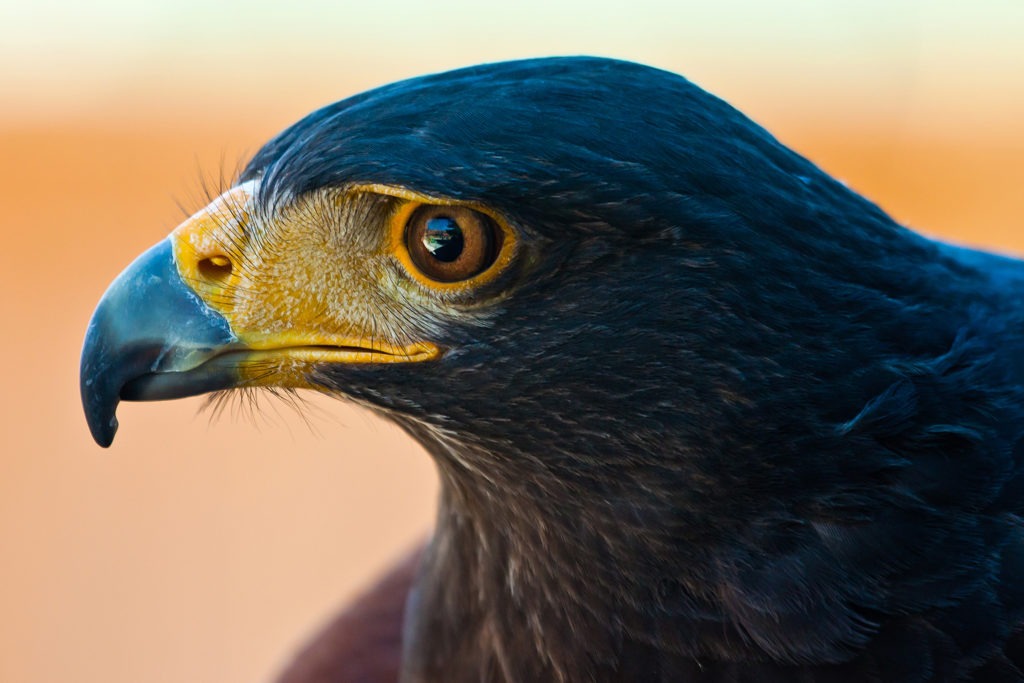Overview
“Where I Live”
Harris’s hawks are found in the southwestern U.S. and further south into Mexico, Central America, and parts of South America. They inhabit open, dry country such as cactus deserts, scrub, grasslands, agricultural lands, and river woods.
“How I Live There”
Harris’s hawks are unusual birds of prey because they are social. They form complex social hierarchies and are usually seen together in small family groups. The breeding, or alpha, female is dominant to all other hawks in the group. If there is a second female in the group, she is subordinate to the alpha female but dominant to all males in the group.
Harris’s hawks engage in cooperative hunting, cooperative breeding, and cooperative protection. When one hawk spots a predator, it sounds an alarm to alert the group. When perching space is scarce (such as on a cactus), these birds may engage in “back-stacking,” which literally means standing on each other’s backs!
These hawks hunt early or late in the day. When in pursuit of prey, they fly low and with great agility, chasing their quarry around cacti or bushes and through scrub. Individual Harris’s hawks catch small prey such as rodents, birds, and lizards. Two or more will work together to bring down larger prey such as jackrabbits or turkeys. They will take turns pursuing until the pursued wears out and just can’t run anymore.
“Making My Mark”
These beautiful raptors have bright yellow beaks and brown and russet colored plumage. Females tend to be larger and heavier than males.
“What Eats Me”
Great horned owls are the most significant predator of Harris’s hawks. Coyotes and common ravens also threaten young hawks, and many different nest predators might try to take eggs or chicks.
Raising Young
When mating, Harris’s hawks form pairs or sometimes triads, with two males mated to the same female. Whether 2 or 3 adult birds, all associate peacefully at the nest and raise offspring together. Both males will supply the female with food on the nest and will feed the chicks. Females breed 2 or 3 times per year and incubate their eggs for 33-36 days each time. After the chicks hatch, they spend about 6 weeks on the nest. During this time, the adult birds and possibly older siblings from an earlier brood will bring them food. The chicks fledge after about 6 weeks but still stay near the nest for another 3 to 4 months. They then either disperse to establish new territories or may remain with the family group for up to 3 years.
Conservation
Harris’s hawks have an extremely large range and are currently listed as a species of “least concern” by the IUCN, the world’s leading conservation organization.
Taxonomy
- Kingdom: Animalia
- Phylum: Chordata
- Subphylum: Vertebrata
- Class: Aves
- Order: Accipitriformes
- Family: Accipitridae
- Genera: Parabuteo
- Species: unicinctus
What is an Animal Ambassador?
The Maryland Zoo refers to its special collection of education program animals as “Animal Ambassadors.” The Zoo currently cares for more than 60 Animal Ambassadors, representing more than 40 species, both native and exotic. These animals are managed separately from the rest of the Zoo’s collection and cannot be seen on exhibit at the Zoo. However, many can be seen up close and personal on a rotating basis at Creature Encounters, the Zoo’s outdoor education center; at camp and school programs at the Zoo; as featured participants in community-based Outreach programs; and at special events on and off Zoo grounds.
Animal Ambassadors spend countless hours working with their human handlers, developing bonds of trust and communication that will allow them to appear in front of audiences large and small. They are not show animals. They behave naturally, focusing audiences’ attention on their natural behaviors and adaptations and giving living, breathing meaning to concepts and topics that students may be studying.
Animal Ambassadors travel all over the state of Maryland and beyond, and many also make local and national media appearances, educating about wildlife while representing the Zoo and its commitments to animal welfare and conservation.
What is The Animal Embassy?
The Animal Embassy at The Maryland Zoo is an off-exhibit area that is not open to the public. It is where the Zoo’s “Animal Ambassadors,” or education program animals, live. The Embassy is home to more than 60 individual animals representing more than 40 different species. It is staffed by its own dedicated group of keepers and volunteers and has both indoor and outdoor living space for the animals.

